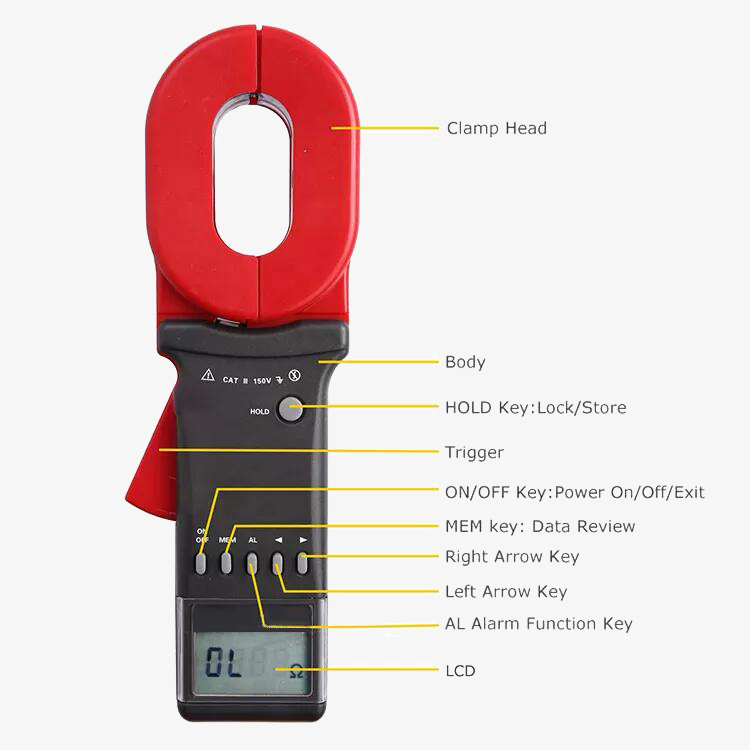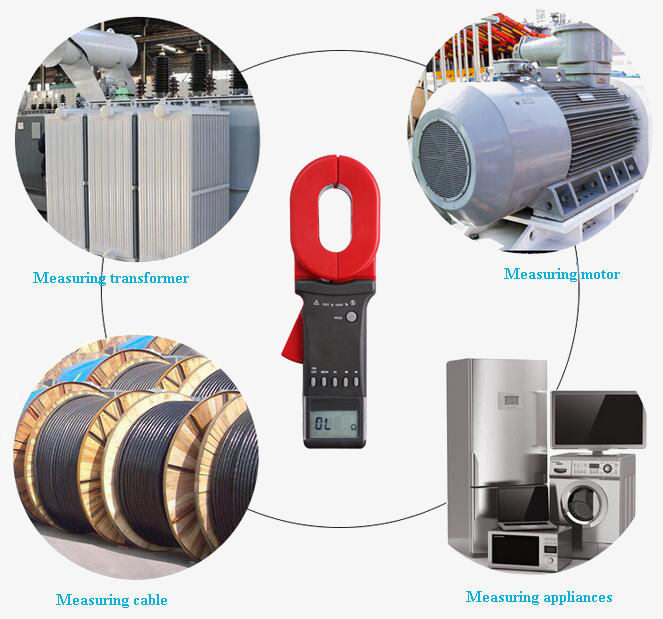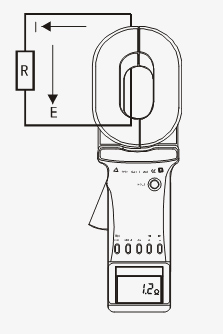Clamp-on earth resistance tester can accurately test ground resistance with a measurement range from 0.01Ω to 200Ω. Digital ground testers are suitable for grounding system measurements in power systems, telecommunications, meteorology, oil fields and buildings.

Digital earth resistance tester is available with a 32mm clamp and 0.010Ω~200Ω measure range.
- This reliable resistance tester is a high-quality ground resistance tester.
- The clamp-on ground insulation tester has a jaw opening size of 32mm, and its sturdy design has become an electrical instrument with superior performance.
- The ground resistance test is a non-contact measurement, which is safe and fast.
- When measuring the loop grounding system, there is no need to disconnect the grounding lead and the auxiliary grounding electrode, which saves time and achieves better results.
- The clamp ground resistance tester can measure ground faults that cannot be measured by traditional methods and is suitable for occasions where traditional methods cannot be used.
- It has the functions of sound and light alarm, data storage, data retention and so on.
- The LCD clearly displays the measurement data with high definition, and the data can be displayed in a backlight.
Applications
sisco earth resistance tester is available with a measuring range of 0.00Ω-300kΩ. The clamp earth resistance tester is widely applied in ground resistance measurement, and loop resistance measurement in fields such as electric power, telecommunications, meteorology, oil field, architecture and industrial electrical equipment, etc. When measuring the ground system with a loop, there is no need to disconnect the ground wire without an auxiliary electrode, which means safer and faster.

| Model | SISCO-ERT-2000A+ |
| Resistance Range | 0.010Ω~200Ω |
| Current Range | - |
| Clamp Size | 65mm×32mm |
| Tester Size | 285mm×85mm×56mm |
| Resistance Tester Weight | 2.3kg (including accessories) |
| Power Supply | 6V DC ( 4 PCS of No.5 Alkaline dry batteries) |
| Single Measurement Time | 0.5 second |
| LCD Screen | 4 Digits LCD display, 47mm×28.5mm |
| Data Memory | 99 groups |
| Audible And Visible Alarm | "du—du—du" for alarming, press AL to turn on/off |
| Alarm Threshold Setting Range | Resistance: 1-199Ω |
| Jaw Opening Size | 32mm |
| Protection Class | Double insulation |
| Shift | Automatically |
| Accessories | Resistance Tester: 1PCS; Test Ring: 1PCS; Instrument Case: 1PCS |
| Clamp Meter Weight | About 1100g (including battery) |
Resistance Measurement Accuracy
| Range | Resolution | Accuracy |
| 0.010Ω-0.099Ω | 0.001Ω | ±(1%rdg+0.01Ω) |
| 0.10Ω-0.99Ω | 0.01Ω | ±(1%rdg+0.01Ω) |
| 1.0Ω-49.9Ω | 0.1Ω | ±(1%rdg+0.1) |
| 50.0Ω-99.5Ω | 0.5Ω | ±(1.5%rdg+0.5) |
| 100Ω-200Ω | 1Ω | ±(2%rdg+1Ω) |
Q1: What is a clamp-on earth resistance tester?
A1: The clamp-on earth resistance tester can measure the connection resistance of any looped system without using an auxiliary ground rod or interrupting the grounding of the equipment under test. As long as the ground wire or ground rod is clamped with the clamp head, the ground resistance can be measured safely and quickly. It can also be applied to multiple parallel grounding systems. The clamp-on ground resistance tester can measure the leakage current of 1MA, and the neutral line current can reach 20A. This function is especially important when the ground network to be tested contains large noise and harmonics.
Q2: How does a clamp ground resistance tester work?
A2: The basic principle of the clamp ground resistance tester to measure the grounding resistance is to measure the loop resistance. The jaw part of the clamp meter consists of a voltage coil and a current coil. The voltage coil provides the excitation signal and induces a potential E on the loop under the test. Under the action of the potential E, a current I will be generated in the circuit under test. The clamp meter measures E and I, and the measured resistance R can be obtained by the following formula. The formula is R=E/I. This is how a clamp-on ground resistance tester works.
Q3: What is the earth resistance tester used for?
A3: The ground resistance tester can accurately measure the grounding impedance, grounding resistance and grounding reactance of large grounding grids.
- It accurately measures the surface potential gradient in the large-scale grounding grid area.
- Earth resistance tester can measure the contact potential difference, contact voltage, step potential difference and step voltage of large grounding grids.
- Measure the transfer potential of large-scale grounding grids and soil resistivity accurately.
- Digital earth resistance tester is used to measure the on-resistance of the grounding down-conductor.
Tips: Why do you need to test ground resistance?
Using a digital earth resistance tester to measure the grounding resistance, we can judge whether the grounding resistance is within a reasonable range based on this value to achieve the effect of protecting the grounding device. Electric shock can be prevented if a grounding resistance is required when installing electrical equipment. Because some electrical enclosures are made of metal, after a long time of use, they will inevitably be damaged, resulting in the destruction of the insulator. In order to avoid electric shock accidents, a ground resistance tester is required.
Thank you for buying industrial test and measurement equipment on SISCO.com, all products sold by SISCO and the partner cover a 12 months warranty, effective from the date of receiving the products.
What is covered?
SISCO is responsible for providing free spare parts, and free technical support to assist the customer to repair the defective products until the problem is solved.
What is not covered?
- Product purchased from anyone other than a SISCO store or a SISCO authorized reseller.
- Expendable parts.
- Routine cleaning or normal cosmetic and mechanical wear.
- Damage from misuse, abuse or neglect.
- Damage from use of parts other than SISCO approved.
- Damage from use outside the product’s usage or storage parameters.
- Damage from use of parts not sold by SISCO.
- Damage from modification or incorporation into other products.
- Damage from repair or replacement of warranted parts by a service provider other than a SISCO authorized service provider.
- Damage caused by the application environment not meeting the product usage requirements and the failure to perform preventive maintenance.

